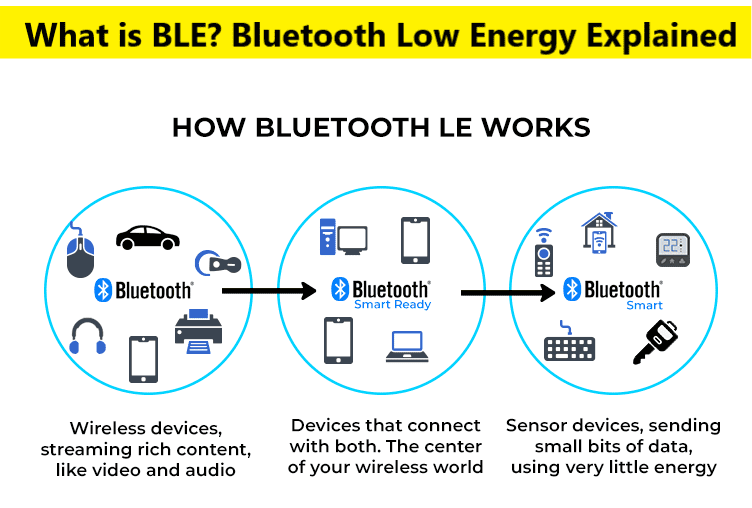
Bluetooth Low Energy (BLE) is one of the most widely applicable low-power connectivity standards. In the rapidly evolving innovations in wireless technology, Bluetooth Low Energy (BLE) has emerged as a power-efficient solution for a variety of applications. In this blog post, we will discuss BLE i.e Bluetooth Low Energy, and will shed light on its capabilities and applications in the ever-evolving tech landscape.
What is Bluetooth Low Energy (BLE) ?
BLE stands for Bluetooth Low Energy (BLE) is a power-conserving type of Classic Bluetooth. BLE is form of wireless communication, which primary application is short distance transmission of small amounts of data i.e low bandwidth. Unlike classic Bluetooth which is always in the ON state, BLE remains in sleep mode constantly except for when a connection is initiated. This makes it consume very low power. BLE consumes approximately 100x less power than Bluetooth which depends on your application.
Features of Bluetooth Low Energy
IoT Centric Design
BLE is designed with IoT application in mind. Features of Bluetooth low energy like Limited operational power, memory addresses the unique constrains of IoT devices. BLE allows IoT devices to operate for extended periods without frequent battery replacement or recharge.
Low Power Consumption
Low power duty and optimized data transmission mechanism of Bluetooth low energy enable it to operate on minimal power making it ideal for battery operated devices. BLE devices mostly remain in sleep mode and only wakes up to send or receive data, this makes it even energy conserving.
GATT
GATT, which stands for Generic Attribute Profile, is a framework used in Bluetooth Low Energy (BLE) for discovering services and characteristics on a device. GATT defines transfer of data back and forth using concepts called services and characteristics. Service is collection of data and associate behavior to complete particular function and characteristic is a value used in service along with properties and configuration information.
Fast Connection Setup
BLE can enable connection in milliseconds making it ideal for the applications that requires frequent but short and fast data transfer.
Security
AES-128 encryption feature of BLE allows protecting data transmitted between the devices and helps to establish trusted and secure connection.
Low Latency
Device Roles and Asymmetry
In the context of BLE-equipped devices, it's crucial to comprehend the architectural asymmetry which is present in the technology. Devices can have a central or peripheral role, like in a smartphone (central) and a smart band (peripheral).
Dual-Mode Devices
To overcome the restriction of communication solely between a central and a peripheral device, some devices are configured to operate in both central and peripheral modes simultaneously. This dual-mode configuration is common in smartphones, they have the ability to function as both central and peripheral devices.
Difference Between Bluetooth Low Energy and Classic Bluetooth
Bluetooth Classic is designed for continuous, both way communication, whereas BLE transfers smaller packets of data over short periods of time;
Bluetooth Low Energy has much smaller energy consumption compared with Bluetooth classic
Bluetooth Classic is not so limited, it has a longer range and higher data throughout.
|
|
|
|
|
|
|
|
|
|
|
|
|
|
|
|
|
|
|
|
|
|
|
|
|
|
|
|
|
|
Espressif and BLE Integration
Espressif, a leading provider of wireless systems-on-chip (SoCs), has played a significant role in providing integrated BLE into its development boards and controllers. The integration of BLE into Espressif's systems has enabled developers to create intricate IoT solutions with enhanced connectivity and power efficiency.
Espressif's ESP32 series is known for its robust BLE capabilities. The ESP32 SoC combines Wi-Fi and BLE functionalities, providing developers with a powerful and flexible platform for building connected devices.
Applications of Bluetooth Low Energy (BLE)
Wearable Technology
BLE has become a main protocol in the development of wearable devices, powering smartwatches, fitness trackers, and health monitoring devices. Its low power consumption is applied in ensuring these devices can operate for extended periods without frequent recharging.
Healthcare Devices
BLE finds maximum use in healthcare applications, connecting medical devices to smartphones for real-time monitoring. This includes devices like blood glucose monitors, heart rate monitors, and temperature sensors.
Smart Home System
BLE is a key enabler of smart home ecosystems. From smart bulbs and thermostats to door locks and security systems, BLE provides seamless communication between devices, enhancing the overall smart home experience.
Asset Tracking
BLE is used for asset tracking applications, and businesses to monitor the location of assets within a limited space. This is valuable in industries such as logistics, where real-time tracking can streamline operations.
Conclusion
In conclusion, Bluetooth Low Energy (BLE) has evolved as a main technology in the development of Internet of Things, it is transforming how devices communicate with each other. Its low power consumption and diverse applications make BLE an important addition in the Internet of Things (IoT). As technology continues to advance, the role of BLE is set to expand, driving innovation and connectivity across a wide range of industries.
If you are looking for BLE modules or Bluetooth modules, or different microcontrollers from brands such as Espressif to implement BLE in your project reach out to the best electronic components online store at Campus Component today!

